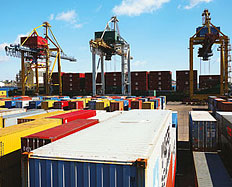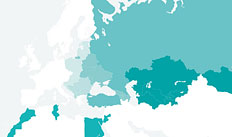COUNTRY ASSESSMENTS
Kyrgyz Republic
HIGHLIGHTS OF THE PAST YEAR
- The authorities have embarked on an ambitious reform programme. It includes major cuts in the number of licences and inspections, as well as plans for radical reforms in public administration, fiscal policy, mining and energy.
- The economy grew strongly in 2011 but contracted in the first half of 2012. Real GDP grew by 5.7 per cent in 2011 after a decline in 2010, but problems at the biggest mining site in February 2012 caused a temporary economic contraction in the first half of the year.
- The fiscal framework has been strengthened. Key measures included the establishment of a public financial management committee, extension of treasury coverage of general government operations and adoption of a medium-term debt management strategy.
KEY PRIORITIES FOR 2013
- The new government should continue its ambitious plans to improve the business climate. Key priorities for the country are strengthening governance and transparency, protecting private property rights and lowering the cost of doing business by radically simplifying regulation, inspections and licences.
- The role of the state in the banking system should be reduced. The main challenge is to increase confidence in the banking system, including through a successful and transparent privatisation of two large banks.
- The energy sector is in need of modernisation and structural reform. A recently adopted medium-term strategy for sector development needs to be implemented, with a focus on improved public administration over the sector, improved corporate governance and transparency and increased operational efficiency.
MACROECONOMIC PERFORMANCE
The economy has recovered well from the 2010 socio-political crisis. Political stability improved following the presidential elections in October 2011 and the successful formation of a new four-party government. Macroeconomic stability returned as well, with GDP growth recovering to 5.7 per cent in 2011 on the back of strong growth in manufacturing, transport and telecoms, combined with higher gold prices and a rebound in neighbouring countries. The general government deficit was kept below 5 per cent of GDP in 2011, reflecting higher tax revenues and lower than planned expenditures. Inflation decelerated sharply from above 20 per cent in early 2011 to below zero in April 2012 and remained around that level until June, mostly reflecting international commodity price developments. A combination of industrial action and difficult weather conditions in the high-altitude pit at the Kumtor gold mine in early 2012 caused gold production to decline by 65 per cent year-on-year in the first quarter of the year and hence a GDP contraction of almost 6 per cent during the first half of the year. Nevertheless, non-gold GDP has continued to grow by nearly 4 per cent during the same period.
The external position is expected to deteriorate in 2012. The current account balance deficit narrowed in the first half of 2011 due to strong export demand, favourable gold prices and a rapid recovery of remittance inflows, mostly from Russia but remained around 6 per cent of GDP at the end of 2011. The early indications of a slow-down in Russia and Kazakhstan are likely to have a negative impact on exports and remittances in 2012. The situation is not helped by the fact that Kazakhstan introduced various barriers for Kyrgyz food exporters in late 2011. Meanwhile, financial stability has improved and further banking system restructuring is under way. Private sector credit increased by 21 per cent in 2011 and non-performing loans declined from 16 per cent at the end of 2010 to 10 per cent in December 2011. The microfinance sector remains very vibrant and helps to ensure that credit continues to flow to small and medium-sized enterprises.
GDP growth in 2012 will likely be negative. This is a result of the temporary mining sector contraction and unfavourable weather conditions affecting agriculture. The outlook for GDP will depend to a large extent on eurozone developments, which will affect the gold price, as well as economic developments in Russia and Kazakhstan, which will influence remittances and exports.
MAJOR STRUCTURAL REFORM DEVELOPMENTS
The new government has embarked on a radical reform programme to improve public administration and boost the business environment. The first presidential election under a new form of republic governance took place in October 2011. Following the elections, the new government has made major progress with their 100-day action plan focusing on anti-corruption measures. The financial police was liquidated, 72 types of licences were abolished in early 2012 and the number of activities subject to licensing requirements is expected to be reduced further, from 500 before the start of reforms to 220. The level of civil service staff was cut by 15 per cent as a result of restructuring and consolidation of various agencies and a substantial reduction in the number of agencies conducting regular inspections of businesses. Various services provided by the state had been reviewed and their total number was drastically reduced, from around 20,000 to 386. The authorities also adopted a plan for fighting corruption in 2012-14. Related measures include a moratorium on checks and inspections of businesses and implementation of a form of performance-based budgeting which takes into account progress in terms of reforms in various areas as measured by national polls and international rankings of the quality of business environment.
Banking sector reform is proceeding slowly. The banking sector continues to be characterised by a large state presence, but there are plans to privatise two of the largest banks, Zalkar Bank and the Savings and Settlements Company (SSC). The privatisation of Zalkar Bank is expected to be concluded by the end of 2012, while plans for the privatisation of SSC remain uncertain. At present, the authorities use SSC to implement the lending support programme to farmers. The legal framework for the resolution of banking sector problems is weak and impedes restructuring of the four banks currently under conservatorship. The authorities have also progressed in establishing a State Development Bank (SDB) to support economic activity, mainly in agriculture. However, there is no agreement so far on the source of funds for the SDB.
There has been good progress in the area of public finance management (PFM) and the achievements in this area remain on track. Establishment of a high level PFM committee, which became operational in 2012, was a major step forward in this area. The authorities also adopted a decree to extend treasury coverage to the remaining extra-budgetary funds, including the Social Fund. A medium-term debt management strategy was developed and adopted. Further steps are however necessary to strengthen the fiscal framework through better organisation of the Ministry of Finance, and upgrading standards of public procurement.
The authorities have drafted a new law on natural resources and new regulations on licensing in the natural resources sector. These plans were included in the “100 days” reform programme. In April 2012 the government adopted amendments to the regulations on mining licences that would force some holders of a mining licence to establish a business entity and transfer a 20 per cent share of this entity to the state. This was, however, cancelled in June after consultation with investors and representatives of the mining sector. Recently, the parliament has ordered a review of the agreements between Kumtor and the country with a possible increase in the participating rights of the Kyrgyz Republic state. These developments could have a negative impact on the investment climate as they may increase state influence in the sector and create uncertainty among foreign investors regarding the protection of private property rights.
The energy sector remains largely unreformed but the authorities have adopted a medium-term energy sector strategy for 2012-17. The strategy, adopted in July 2012, was prepared in cooperation with the World Bank, the Asian Development Bank and USAID. The priorities identified in the medium-term are improvement of the public administration over the sector, a better management of the energy companies, including improved corporate governance and transparency, and increasing energy efficiency and output.
A new law on public-private partnerships (PPPs) was enacted in February 2012. The law defines a concept of PPPs and provides for private sector participation in the design, financing, construction, restoration and reconstruction of infrastructure facilities under concessions for up to 50 years.
The Kyrgyz Republic became the sixth full member of the Eurasian Development Bank. Membership occurred in September 2011, with the country joining Armenia, Belarus, Kazakhstan, Russia and Tajikistan. Potential accession of the Kyrgyz Republic to the customs union of Belarus, Kazakhstan and Russia remains under negotiation.







